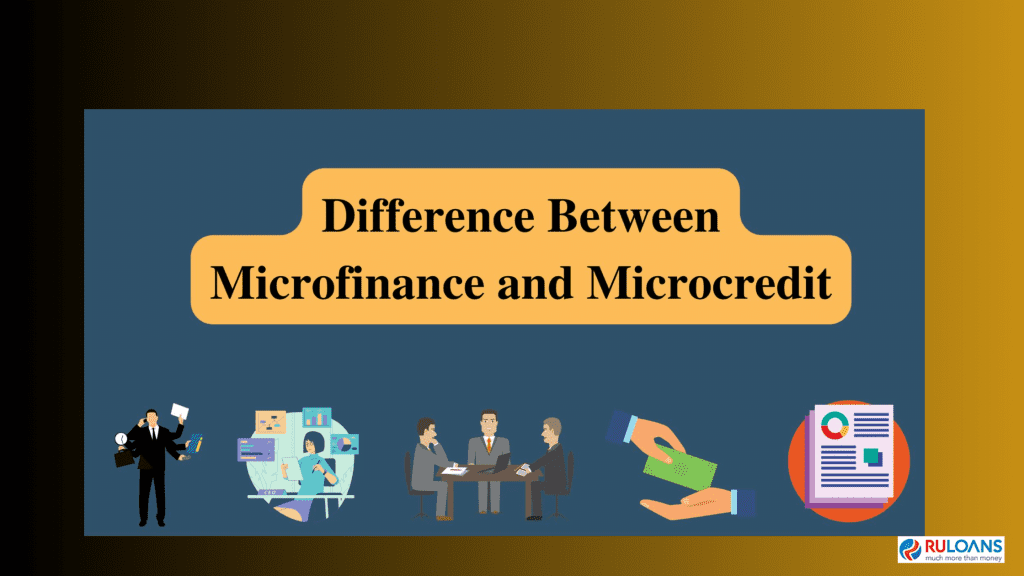Introduction
In the bustling financial ecosystem of India, two terms often used interchangeably are “microcredit” and “microfinance”. While both aim to address the financial needs of the marginalized, they serve distinct functions and have their own significance. Understanding the nuances between them helps in gaining clarity on their role in shaping the economic landscape of the country.
Define Microcredit and Microfinance
Microcredit: Microcredit refers to the provision of small loans to low-income individuals or groups who typically don’t have access to traditional banking services. These loans are intended to support entrepreneurial ventures, aiding individuals in setting up or expanding micro-enterprises. The underlying principle of microcredit is trust; collaterals are often not required, making it easier for the economically disadvantaged to avail of these loans.
Microfinance: Microfinance, on the other hand, is a broader term. While it encompasses microcredit, it also includes other financial services such as savings accounts, insurance, money transfers, and financial education. The objective of microfinance is to offer a comprehensive financial solution for those excluded from the conventional banking system, ensuring that they not only get access to credit but also have avenues to save, invest, and secure their financial future.
Explain the Difference Between Microcredit and Microfinance
At the very heart, while microcredit is purely about providing small loans, microfinance encapsulates a wider array of financial services. Think of microcredit as a subset of microfinance.

For example, a rural farmer might take a microcredit loan to buy seeds at the beginning of a planting season. Once the crops are harvested and sold, he might use a microfinance service to deposit his earnings in a savings account. Should any unforeseen calamity hit, he might lean on micro-insurance (another component of microfinance) to mitigate his losses. Thus, while microcredit fuels his immediate entrepreneurial needs, microfinance provides him with a holistic financial safety net.
Discuss the History of Microfinance
India’s tryst with microfinance traces back to the self-help group (SHG) movement in the 1980s. These groups were community-based, where members would pool in savings and then lend to those in need within the group. The success of SHGs caught the attention of banks, leading to the SHG-Bank Linkage Program in the early 1990s, which formalized the partnership between SHGs and banks.
However, microfinance gained significant traction post-2000, with the establishment of several microfinance institutions (MFIs). These institutions, regulated by the Reserve Bank of India, provide microloans and other financial services to those at the bottom of the economic pyramid. Over the years, the MFI model has evolved, and today, it includes a range of institutions from non-banking financial companies (NBFCs) to small finance banks.
Highlight the Importance of Microfinance
Economic Inclusion: Given India’s vast population, a significant portion remains unbanked or underbanked. Microfinance institutions bridge this gap, ensuring that financial services reach even the most remote corners of the country.
Women Empowerment: Traditionally, women, especially in rural areas, have been sidelined from financial decisions. Microfinance has played a transformative role in empowering women, providing them with financial autonomy and subsequently boosting their socio-economic status.
Promotion of Entrepreneurship: With easy access to credit and financial services, many individuals have embarked on entrepreneurial journeys, setting up small businesses and micro-enterprises. This not only generates income for them but also fuels local economies, leading to job creation and community development.
Protection Against Shocks: Life is unpredictable. Whether it’s a medical emergency, natural calamity, or some unforeseen expenditure, having access to financial services means that individuals have a safety net to fall back on. Micro-insurance, a component of microfinance, provides this very protection.
Financial Literacy: A noteworthy aspect of microfinance is the emphasis on financial education. Many MFIs conduct workshops and training sessions, educating borrowers about savings, investments, and prudent financial management. This ensures that the benefits of microfinance are sustainable in the long run.
Discuss the Different Types of Microfinance Products and Services Offered
Microfinance has evolved far beyond just microloans. Today, the range of products and services cater to diverse financial needs of the economically marginalized:
- Microloans: Small-scale loans primarily for entrepreneurial activities. These usually have a shorter duration, and minimal documentation, and are often disbursed without collateral.
- Microsavings: Allows individuals to save small amounts of money for future use. Given that traditional banks often require a minimum balance, micro savings accounts provide a feasible alternative for those with limited means.
- Micro-insurance: Tailored to suit the needs of the low-income group, micro-insurance products cover life, health, and even livestock or crop insurance at affordable premiums.
- Micro-pensions: Retirement solutions designed for those working in the unorganized sector, ensuring they have a financial safety net in their old age.
- Money Transfers: Many microfinance institutions (MFIs) facilitate domestic money transfers, especially crucial for migrant workers who need to send money to their families in remote areas.
- Financial Education: Workshops and training sessions that empower clients with knowledge on managing finances, and savings, and understanding the nuances of borrowing.
Explain How Microfinance Can Help People in Poverty Improve Their Lives
- Entrepreneurial Ventures: Microloans allow individuals to invest in small businesses or expand existing ones. This stimulates income generation, ensuring a steady source of livelihood.
- Financial Security: Products like microsavings and micro-insurance ensure that individuals have a financial buffer during emergencies. This reduces their vulnerability to unforeseen shocks.
- Empowerment and Dignity: By providing financial autonomy, especially to women, microfinance institutions instill confidence and promote decision-making within households.
- Job Creation: As more individuals embark on entrepreneurial activities, they create job opportunities, benefiting the larger community.
- Promotion of Financial Literacy: As clients become financially literate, they make better and informed decisions, ensuring long-term financial sustainability.
Explore the Challenges Faced by Microfinance Institutions
- High Operational Costs: Given the small size of transactions, the cost of disbursing microloans and maintaining microsavings accounts can be high relative to the revenue generated.
- Repayment Concerns: While the repayment rates have traditionally been high, there have been instances of loan defaults, especially when multiple MFIs operate in the same region.
- Regulatory Hurdles: The regulatory framework for MFIs has seen multiple changes. Navigating these ever-evolving regulations can be challenging for institutions.
- Over-indebtedness: There’s a risk of borrowers availing loans from multiple sources, leading to over-indebtedness, which is detrimental both for the client and the institution.
- Limited Products: Despite the variety, many MFIs still predominantly focus on credit, with other services like insurance and pensions taking a backseat.
Discuss the Future of Microfinance
- Technological Integration: With the digital revolution , MFIs are leveraging technology for loan disbursals, repayments, and even financial education. Platforms like UPI (Unified Payments Interface) are expected to play a significant role.
- Diverse Product Portfolio: The future might witness MFIs offering a more diverse range of products, catering to varied financial needs, ensuring holistic financial inclusion.
- Collaborations: Tie-ups with mainstream financial institutions, fintech startups, and even e-commerce platforms can expand the reach and efficiency of MFIs.
- Regulatory Evolution: The regulatory landscape is expected to evolve, providing a more stable and conducive environment for MFIs to operate.
- Global Best Practices: As the microfinance sector matures, India might look towards global best practices, customizing them to suit the unique socio-economic landscape of the country.
Conclusion
The vibrant microfinance landscape, underpinned by both microcredit and a broader spectrum of financial services, has been pivotal in reshaping the nation’s economic fabric. While microcredit acts as a catalyst for entrepreneurial endeavours, microfinance, with its diversified suite of services, ensures comprehensive financial security and growth opportunities for marginalized communities.
With roots dating back to the self-help group movement, India’s journey with microfinance has traversed challenges and milestones, culminating in the multifaceted sector we witness today. From fueling entrepreneurial spirit and fostering financial literacy to safeguarding against unforeseen adversities and propelling women’s empowerment, microfinance stands as a beacon of inclusive development.
As we gaze into the future, with technological advances and global best practices knocking at its doors, the microfinance sector is poised for a transformation that promises to further democratize access to financial services.
Key Takeaways
- Microcredit vs. Microfinance: While microcredit pertains solely to the provision of small loans, microfinance envelops a broader range of financial services, with microcredit being a subset.
- Historical Roots: India’s engagement with microfinance began with the SHG movement in the 1980s, which subsequently led to the establishment of numerous MFIs post-2000.
- Significance of Microfinance: From bridging the gap between the banked and unbanked to championing women’s financial independence, microfinance plays a multifaceted role in socio-economic development.
- Microfinance Offerings: Apart from microloans, the sector offers micro-savings, micro-insurance, micro-pensions, money transfers, and financial education.
- Impacting Lives: By fostering entrepreneurship, ensuring financial security, promoting financial literacy, and creating job opportunities, microfinance is instrumental in elevating the living standards of the impoverished.
- Challenges: Despite its successes, the sector grapples with high operational costs, repayment concerns, regulatory challenges, the risk of over-indebtedness, and a skewed focus on credit.
- Future Outlook: Integration of technology, expansion of product portfolios, collaborative initiatives, evolving regulations, and assimilation of global best practices herald a promising future for microfinance.










